HONDA ODYSSEY 1998 Owners Manual
Manufacturer: HONDA, Model Year: 1998, Model line: ODYSSEY, Model: HONDA ODYSSEY 1998Pages: 272, PDF Size: 2.67 MB
Page 251 of 272
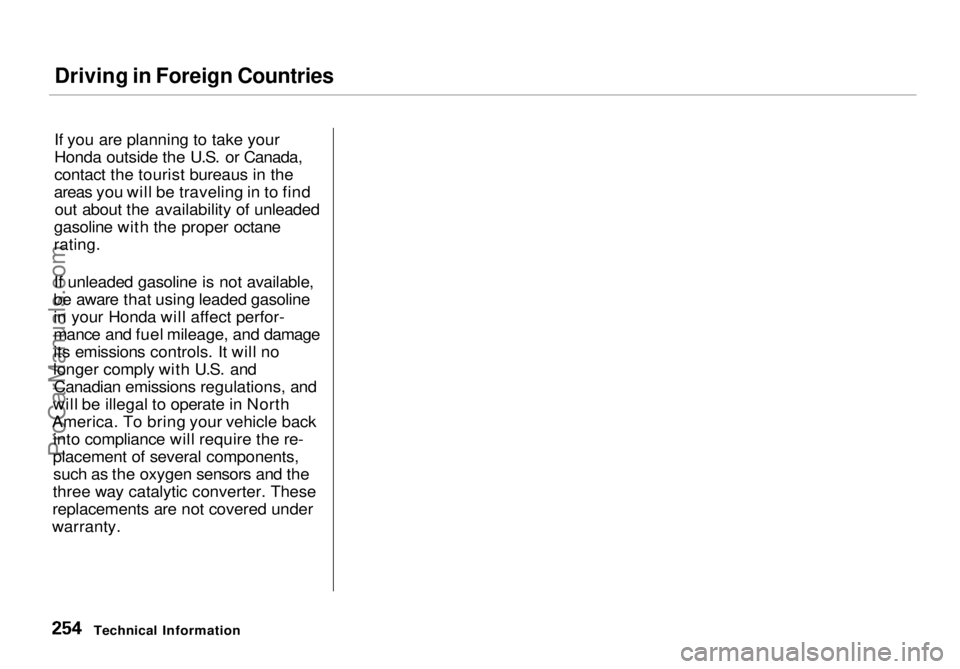
Driving in Foreign Countries
If you are planning to take your
Honda outside the U.S. or Canada,
contact the tourist bureaus in the
areas you will be traveling in to find out about the availability of unleaded
gasoline with the proper octane
rating.
If unleaded gasoline is not available,
be aware that using leaded gasoline
in your Honda will affect perfor-
mance and fuel mileage, and damage
its emissions controls. It will no
longer comply with U.S. and Canadian emissions regulations, and
will be illegal to operate in North
America. To bring your vehicle back into compliance will require the re-
placement of several components, such as the oxygen sensors and the
three way catalytic converter. These
replacements are not covered under
warranty.
Technical InformationProCarManuals.comMain Menu Table of Contents s t
Page 252 of 272
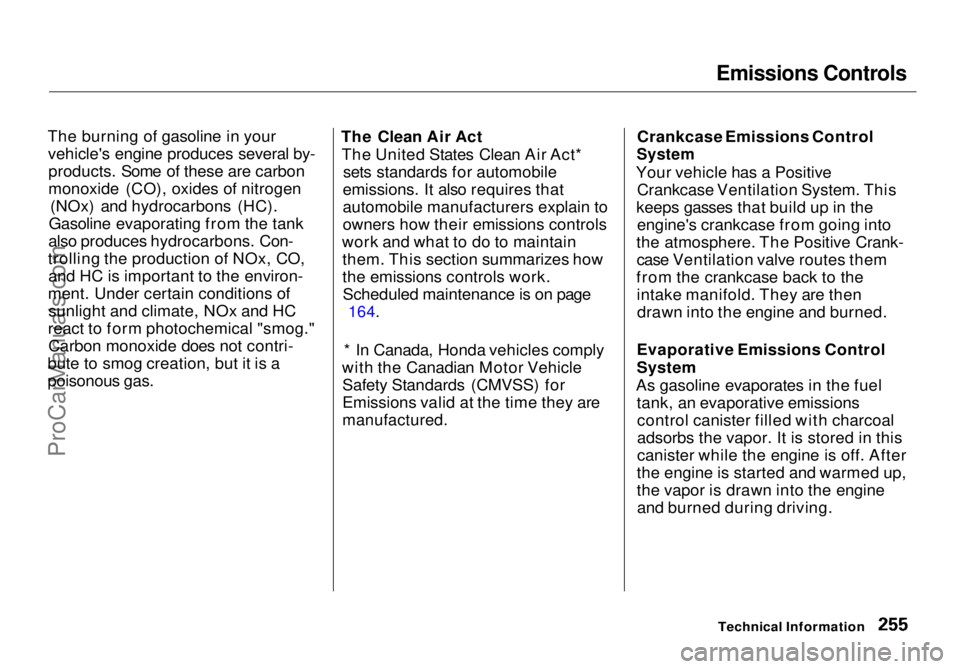
Emissions Controls
The burning of gasoline in your vehicle's engine produces several by-products. Some of these are carbon
monoxide (CO), oxides of nitrogen (NOx) and hydrocarbons (HC).
Gasoline evaporating from the tank
also produces hydrocarbons. Con-
trolling the production of NOx, CO, and HC is important to the environ-
ment. Under certain conditions of sunlight and climate, NOx and HC
react to form photochemical "smog." Carbon monoxide does not contri-
bute to smog creation, but it is a
poisonous gas. The Clean Air Act
The United States Clean Air Act* sets standards for automobile
emissions. It also requires that
automobile manufacturers explain to
owners how their emissions controls
work and what to do to maintain them. This section summarizes how
the emissions controls work.Scheduled maintenance is on page
164.
* In Canada, Honda vehicles comply
with the Canadian Motor Vehicle Safety Standards (CMVSS) for
Emissions valid at the time they are
manufactured.
Crankcase Emissions Control
System
Your vehicle has a Positive Crankcase Ventilation System. This
keeps gasses that build up in the engine's crankcase from going into
the atmosphere. The Positive Crank- case Ventilation valve routes them
from the crankcase back to the intake manifold. They are thendrawn into the engine and burned.
Evaporative Emissions Control
System
As gasoline evaporates in the fuel tank, an evaporative emissionscontrol canister filled with charcoal
adsorbs the vapor. It is stored in this
canister while the engine is off. After
the engine is started and warmed up,
the vapor is drawn into the engine and burned during driving.
Technical InformationProCarManuals.comMain Menu Table of Contents s t
Page 253 of 272
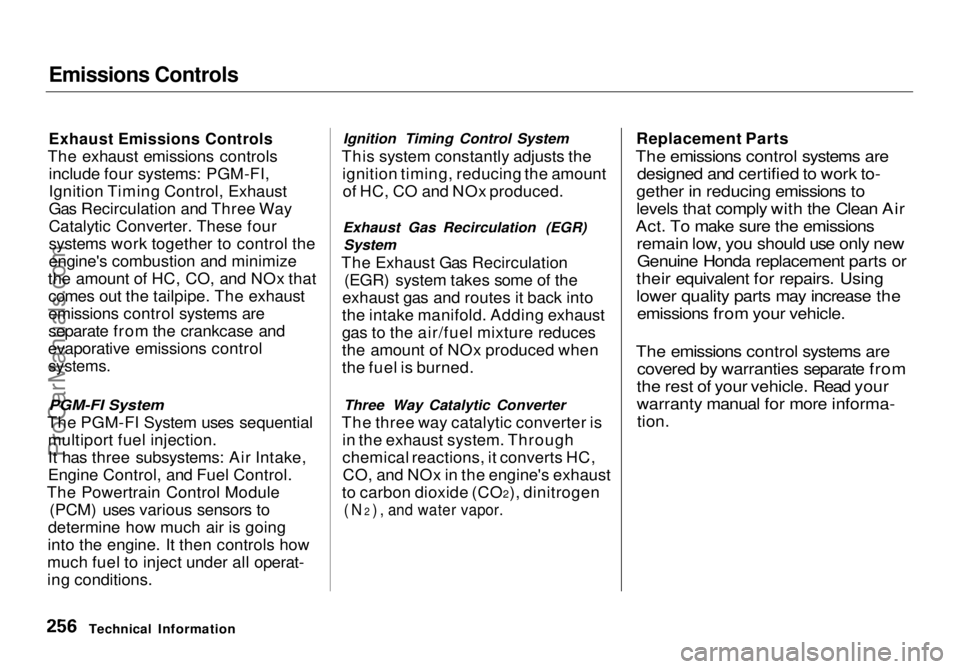
Emissions Controls
Exhaust Emissions Controls
The exhaust emissions controls include four systems: PGM-FI,
Ignition Timing Control, Exhaust
Gas Recirculation and Three Way
Catalytic Converter. These four
systems work together to control the
engine's combustion and minimize
the amount of HC, CO, and NOx that comes out the tailpipe. The exhaust
emissions control systems are
separate from the crankcase and
evaporative emissions control
systems.
PGM-FI System
The PGM-FI System uses sequential multiport fuel injection.
It has three subsystems: Air Intake,
Engine Control, and Fuel Control.
The Powertrain Control Module (PCM) uses various sensors to
determine how much air is going
into the engine. It then controls how
much fuel to inject under all operat-
ing conditions. Ignition Timing Control System
This system constantly adjusts the ignition timing, reducing the amountof HC, CO and NOx produced.
Exhaust Gas Recirculation (EGR)
System
The Exhaust Gas Recirculation (EGR) system takes some of the
exhaust gas and routes it back into
the intake manifold. Adding exhaust
gas to the air/fuel mixture reduces
the amount of NOx produced when
the fuel is burned.
Three Way Catalytic Converter
The three way catalytic converter is in the exhaust system. Through
chemical reactions, it converts HC,CO, and NOx in the engine's exhaust
to carbon dioxide (CO2), dinitrogen
(N2), and water vapor.
Replacement Parts
The emissions control systems are designed and certified to work to-
gether in reducing emissions to
levels that comply with the Clean Air
Act. To make sure the emissions remain low, you should use only newGenuine Honda replacement parts or
their equivalent for repairs. Using
lower quality parts may increase the emissions from your vehicle.
The emissions control systems are covered by warranties separate from
the rest of your vehicle. Read your
warranty manual for more informa-
tion.
Technical InformationProCarManuals.comMain Menu Table of Contents s t
Page 254 of 272
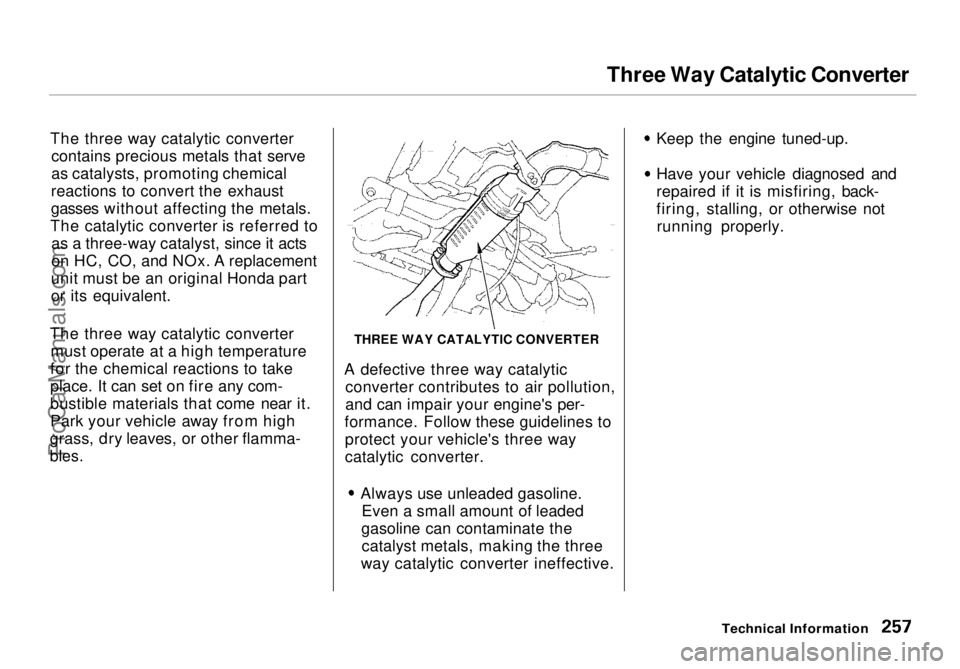
Three Way Catalytic Converter
The three way catalytic converter contains precious metals that serve
as catalysts, promoting chemical
reactions to convert the exhaust
gasses without affecting the metals.
The catalytic converter is referred to as a three-way catalyst, since it acts
on HC, CO, and NOx. A replacement
unit must be an original Honda part
or its equivalent.
The three way catalytic converter must operate at a high temperature
for the chemical reactions to take
place. It can set on fire any com-
bustible materials that come near it.
Park your vehicle away from high
grass, dry leaves, or other flamma-
bles.
A defective three way catalytic
converter contributes to air pollution,
and can impair your engine's per-
formance. Follow these guidelines to protect your vehicle's three way
catalytic converter.
Always use unleaded gasoline.Even a small amount of leaded
gasoline can contaminate the catalyst metals, making the three
way catalytic converter ineffective. Keep the engine tuned-up.
Have your vehicle diagnosed and
repaired if it is misfiring, back-
firing, stalling, or otherwise not
running properly.
Technical Information
THREE WAY CATALYTIC CONVERTERProCarManuals.comMain Menu Table of Contents s t
Page 255 of 272
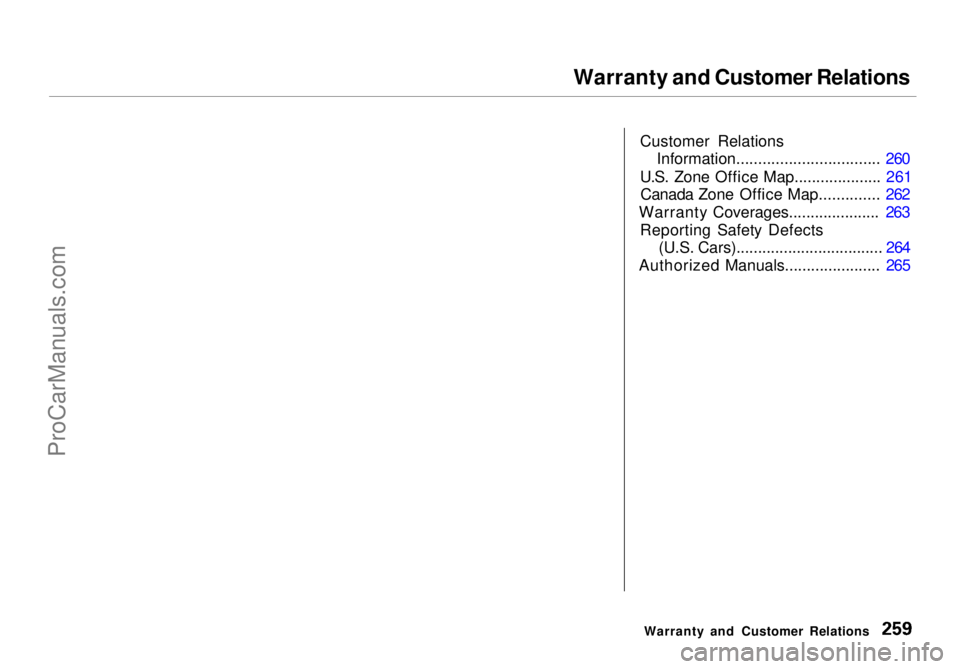
Warranty and Customer Relations
Customer RelationsInformation................................. 260
U.S. Zone Office Map.................... 261 Canada Zone Office Map.............. 262
Warranty Coverages..................... 263 Reporting Safety Defects (U.S. Cars).................................. 264
Authorized Manuals...................... 265
Warranty and Customer RelationsProCarManuals.comMain Menu s t
Page 256 of 272
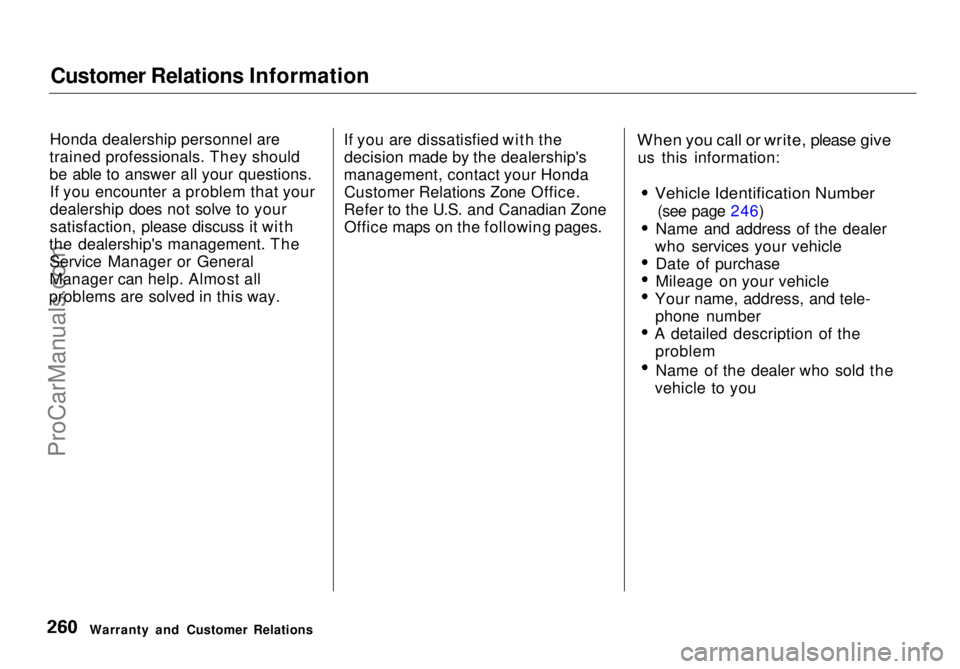
Customer Relations Information
Honda dealership personnel are
trained professionals. They should
be able to answer all your questions. If you encounter a problem that your
dealership does not solve to your
satisfaction, please discuss it with
the dealership's management. The Service Manager or General
Manager can help. Almost all
problems are solved in this way. If you are dissatisfied with the
decision made by the dealership's
management, contact your Honda Customer Relations Zone Office.
Refer to the U.S. and Canadian Zone Office maps on the following pages.
When you call or write, please give
us this information:
Vehicle Identification Number
(see page 246)
Name and address of the dealer
who services your vehicle Date of purchase
Mileage on your vehicle
Your name, address, and tele- phone number
A detailed description of the problem
Name of the dealer who sold the
vehicle to you
Warranty and Customer RelationsProCarManuals.comMain Menu Table of Contents s t
Page 257 of 272
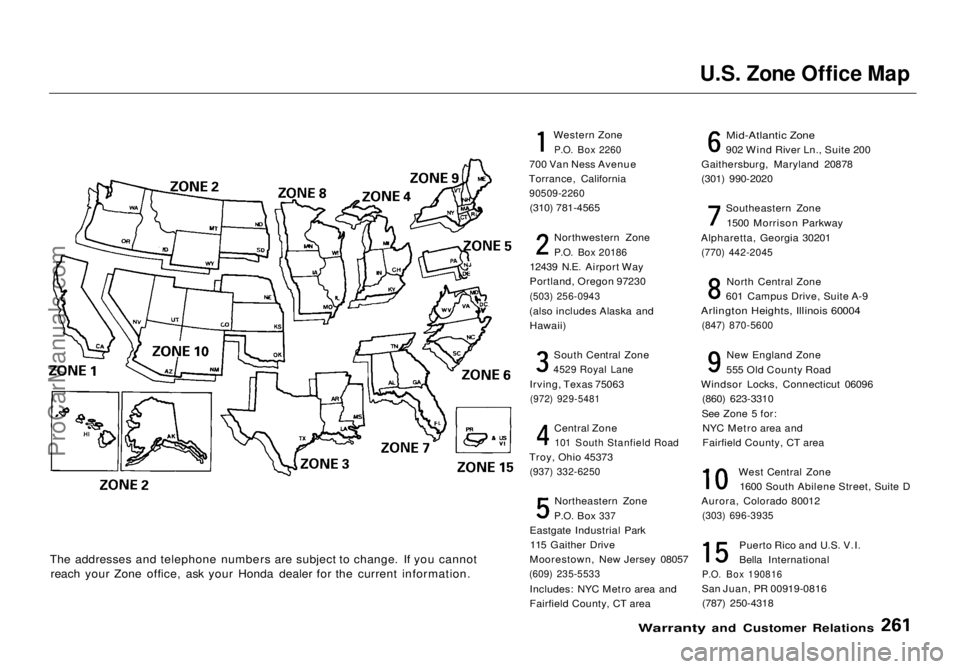
U.S. Zone Office Map
Western Zone
P.O. Box 2260
700 Van Ness Avenue
Torrance, California
90509-2260
(310) 781-4565
Northwestern Zone
P.O. Box 20186
12439 N.E. Airport Way
Portland, Oregon 97230
(503) 256-0943
(also includes Alaska and Hawaii)
South Central Zone
4529 Royal Lane
Irving, Texas 75063
(972) 929-5481
The addresses and telephone numbers are subject to change. If you cannot reach your Zone office, ask your Honda dealer for the current information. Central Zone
101 South Stanfield Road
Troy, Ohio 45373
(937) 332-6250
Northeastern Zone
P.O.
Box
337
Eastgate Industrial Park 115 Gaither Drive
Moorestown, New Jersey 08057
(609) 235-5533
Includes: NYC Metro area and
Fairfield County, CT area
Mid-Atlantic Zone
902 Wind River Ln., Suite 200
Gaithersburg, Maryland 20878
(301) 990-2020
Southeastern Zone1500 Morrison Parkway
Alpharetta, Georgia 30201
(770) 442-2045
North Central Zone
601 Campus Drive, Suite A-9
Arlington Heights, Illinois 60004
(847) 870-5600
New England Zone
555 Old County Road
Windsor Locks, Connecticut 06096 (860) 623-3310
See Zone 5 for: NYC Metro area and
Fairfield County, CT area
West Central Zone1600 South Abilene Street, Suite D
Aurora, Colorado 80012
(303) 696-3935
Puerto Rico and U.S. V.I.
Bella International
P.O. Box 190816
San Juan, PR 00919-0816 (787) 250-4318
Warranty and Customer Relations
ProCarManuals.comMain Menu Table of Contents s t
Page 258 of 272
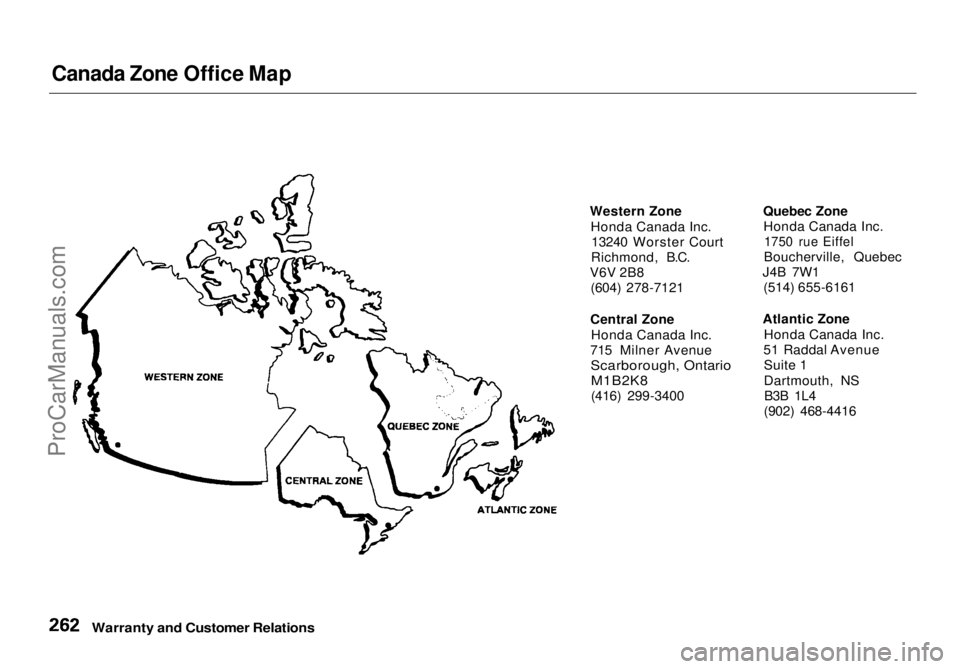
Canada Zone Office Map
Western ZoneHonda Canada Inc.13240 Worster Court
Richmond, B.C.
V6V 2B8 (604) 278-7121
Central Zone Honda Canada Inc.
715 Milner Avenue
Scarborough, Ontario
M1B2K8
(416) 299-3400 Quebec Zone
Honda Canada Inc.
1750 rue Eiffel
Boucherville, Quebec
J4B 7W1 (514) 655-6161
Atlantic Zone Honda Canada Inc.
51 Raddal Avenue Suite 1
Dartmouth, NSB3B 1L4
(902) 468-4416
Warranty and Customer RelationsProCarManuals.comMain Menu Table of Contents s t
Page 259 of 272
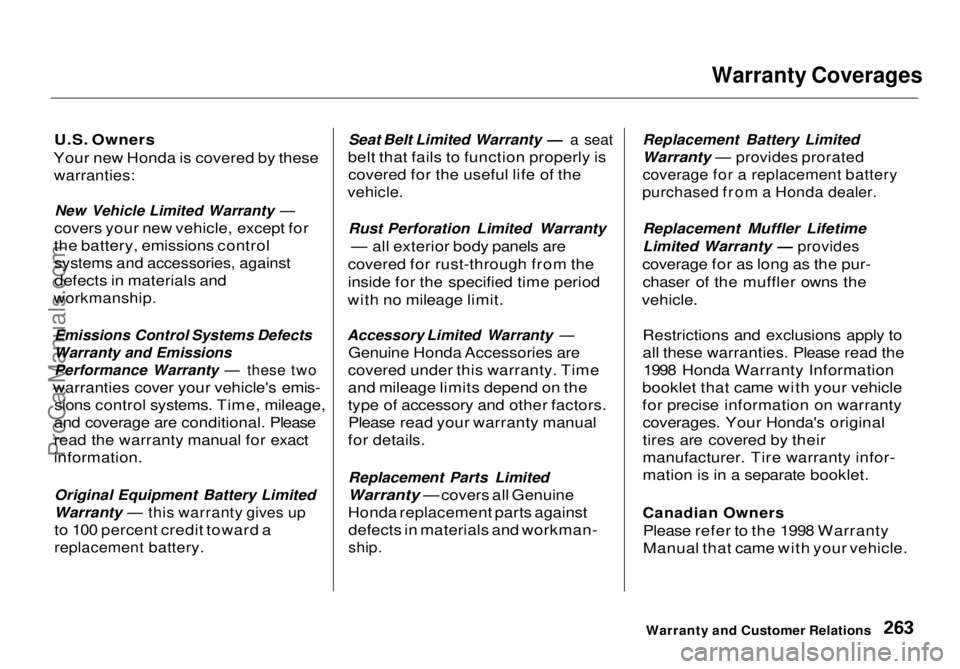
Warranty Coverages
U.S. Owners
Your new Honda is covered by these
warranties:
New Vehicle Limited Warranty —
covers your new vehicle, except for
the battery, emissions control
systems and accessories, against
defects in materials and
workmanship.
Emissions Control Systems Defects
Warranty and Emissions
Performance Warranty — these two
warranties cover your vehicle's emis- sions control systems. Time, mileage,
and coverage are conditional. Please
read the warranty manual for exact
information.
Original Equipment Battery Limited
Warranty — this warranty gives up
to 100 percent credit toward a
replacement battery.
Seat Belt Limited Warranty — a seat
belt that fails to function properly is covered for the useful life of the
vehicle.
Rust Perforation Limited Warranty
— all exterior body panels are
covered for rust-through from the
inside for the specified time period
with no mileage limit.
Accessory Limited Warranty —
Genuine Honda Accessories are
covered under this warranty. Time
and mileage limits depend on the
type of accessory and other factors. Please read your warranty manual
for details.
Replacement Parts Limited
Warranty — covers all Genuine
Honda replacement parts against defects in materials and workman-
ship.
Replacement Battery Limited
Warranty — provides prorated
coverage for a replacement battery
purchased from a Honda dealer.
Replacement Muffler Lifetime
Limited Warranty — provides
coverage for as long as the pur- chaser of the muffler owns the
vehicle.
Restrictions and exclusions apply to
all these warranties. Please read the1998 Honda Warranty Information
booklet that came with your vehicle
for precise information on warranty coverages. Your Honda's original
tires are covered by their
manufacturer. Tire warranty infor-
mation is in a separate booklet.
Canadian Owners
Please refer to the 1998 Warranty
Manual that came with your vehicle.
Warranty and Customer RelationsProCarManuals.comMain Menu Table of Contents s t
Page 260 of 272
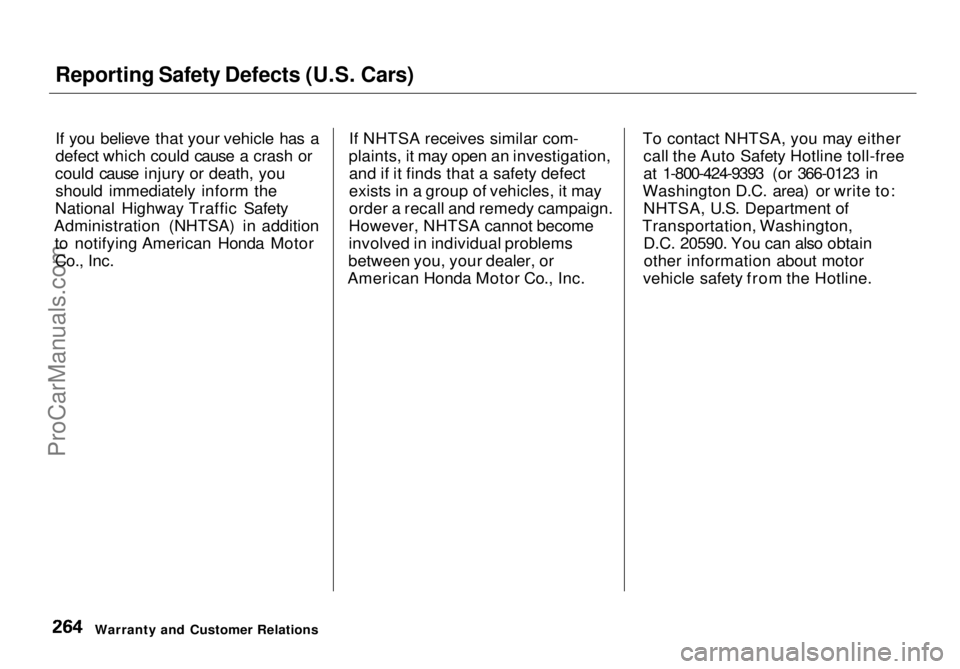
Reporting Safety Defects (U.S. Cars)
If you believe that your vehicle has a
defect which could cause a crash or
could cause injury or death, you should immediately inform the
National Highway Traffic Safety
Administration (NHTSA) in addition to notifying American Honda MotorCo., Inc. If NHTSA receives similar com-
plaints, it may open an investigation, and if it finds that a safety defect
exists in a group of vehicles, it may
order a recall and remedy campaign.
However, NHTSA cannot become
involved in individual problems
between you, your dealer, or
American Honda Motor Co., Inc. To contact NHTSA, you may either
call the Auto Safety Hotline toll-free
at 1-800-424-9393 (or 366-0123 in
Washington D.C. area) or write to: NHTSA, U.S. Department of
Transportation, Washington, D.C. 20590. You can also obtainother information about motor
vehicle safety from the Hotline.
Warranty and Customer RelationsProCarManuals.comMain Menu Table of Contents s t